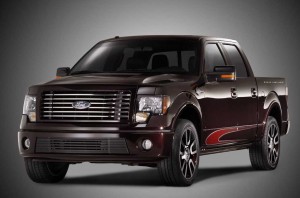
Products like the new F-150 Harley Davidson Edition are driving strong performance for Ford, which surprised skeptics with its second-quarter earnings.
The Ford Motor Co. continued to surprise its critics, this morning, posting only a modest operating loss along with a net profit for the second quarter.
The automaker said it went $424 million into the red on an operating basis, in the second quarter, after excluding special items. However with the special items figured in it posted net income of $2.3 billion, or 69 cents per share.
Including the special items yielded a net gain of $2.8 billion, including a $3.4 billion gain related to debt-reduction actions, the automaker said, in a second quarter financial report released Thursday. “While the business environment remained extremely challenging around the world, we made significant progress on our transformation plan,” said Ford President and CEO Alan Mulally, in a prepared release. Mulally had told reporters, earlier this week, to watch the second quarter financial report carefully.
“Our underlying business is growing progressively stronger as we introduce great new products that customers want and value, while continuing to aggressively restructure our business and strengthen our balance sheet,” said Mulally.
Mulally also noted that Ford had completed several transactions in the second quarter that bolstered its position, including reducing its debt obligations by $10.1. The reduction will save Ford more $500 million annually in interest expenses. In addition, Ford also reached agreement with the UAW, subject to court and other approvals, to allow Ford the option to fund up to half of its VEBA obligations with Ford common stock at market prices instead of fixed prices in 2009, 2010 and 2011.
(As TheDetroitBureau.com reported, on Tuesday, Ford is seeking additional contract concessions from the union that could yield further cost savings, and bar future strikes.)
The automaker also raised $1.6 billion through the issuance of 345 million shares of Ford common stock and reduced structural costs in its automotive business by $1.8 billion, including $1.2 billion in North America.
Ford officials noted the compan finished the second quarter with $21 billion in cash, compared with $21.3 billion at the end of the first quarter of 2009. While automotive operating-related cash flow was $1 billion negative during the second quarter of 2009, it had improved over the $2.7 billion on hand during the first quarter of 2009.
Ford Credit reported a pre-tax profit of $646 million, compared with a pre-tax loss of $294 million a year ago when the U.S. was heading for a financial crisis.
Mulally also stressed that Ford remains on track, based on current planning assumptions, to achieve its key 2011 financial targets, including profitability.
“Ford delivered a very solid quarter, and our transformation plan remains well on track,” said Lewis Booth, Ford executive vice president and chief financial officer. “We strengthened our balance sheet, reduced cash outflows and improved our year-over-year financial results despite sharply lower industry volumes.”
Ford also gained market share in all regions compared with the second quarter of 2008, including the U.S. market, where its share increased by two points to 16.4 percent. Market share in Canada and Mexico also improved and Ford become Canada’s top-selling brand in June, for the first time in 50 years.
Ford’s share of the South American market improved by one point to 10.4 percent. In Europe, Ford market share rose a half point to 9.0 percent, its highest second-quarter level in past 10 years. Ford’s market share was up one-tenth of a point in the Asia Pacific Africa region.
For the second quarter of 2009, Ford’s worldwide automotive sector reported a pre-tax operating loss of $1 billion, compared with a pre-tax loss of $699 million a year ago. The decline reflected lower industry volumes, actions to reduce dealer stocks, higher material costs and unfavorable exchange, largely offset by structural cost reductions, favorable net pricing and improved market share.
Net pricing was about $1.2 billion favorable, primarily explained by higher pricing in the U.S., reflecting the success of new products, including the Ford F-150, Ford Fusion and Ford Mustang, and the continuation of its disciplined approach on incentives.
Worldwide Automotive revenue in the second quarter was $24 billion, down from $34.1 billion a year ago. The decrease is primarily explained by lower volumes and unfavorable exchange rates, partly offset by favorable net pricing. Total vehicle wholesales in the second quarter were 1.17 million units compared with 1.56 million units a year ago.
Strong new products drove market share gains in all regions and helped Ford post further improvements in transaction prices and margins, Mulally said.
Ford’s customer satisfaction with vehicle quality reached its highest level in North America and now equals Toyota; Ford, Lincoln and Mercury brand vehicles had the fewest “things gone wrong” among all domestic automakers; Ford leads the U.S. industry in Insurance Institute for Highway Safety “Top Safety Pick” awards.
